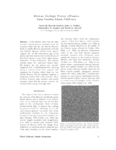- DSpace Home
- →
- Channel Islands
- →
- National Park Service
- →
- California Islands Symposia Documents
- →
- 3rd California Islands Symposium
JavaScript is disabled for your browser. Some features of this site may not work without it.
| dc.contributor.author | Boundy-Sanders, Susan Q. | en |
| dc.contributor.author | Vedder, John G. | en |
| dc.contributor.author | Sanders, Christopher O. | en |
| dc.contributor.author | Howell, David G. | en |
| dc.date.accessioned | 2011-02-09T18:30:09Z | en |
| dc.date.available | 2011-02-09T18:30:09Z | en |
| dc.date.issued | 1993 | en |
| dc.identifier.citation | Boundy-Sanders, Susan Q., John G. Vedder, Christopher O. Sanders and David G. Howell. "Miocene Geologic History of Eastern Santa Catalina Island, California." In: 3rd California Islands Symposium. 1987. 3-14. | en |
| dc.identifier.uri | http://hdl.handle.net/10139/3163 | en |
| dc.description.abstract | Field relations show that the Santa Catalina Island pluton intruded both the Catalina Schist and the San Onofre Breccia. Early to middle Miocene macrofossils from the San Onofre Breccia of East End Quarry support the 19 Ma radiometric age of the pluton and show that the San Onofre Breccia of East End Quarry is one of the oldest known exposures of that formation. The pluton includes about 50% subvertical sheeted dikes. We believe that the pluton was initially emplaced into a rhombochasm-like opening along a transtensional fault segment that separated the Catalina Schist from the San Onofre Breccia. Present exposures represent a moderately shallow level of the intrusion. West of Silver Canyon, map relations and several outcrops show that the pluton overlies the Catalina Schist along a low-angle fault. | en |
| dc.language.iso | en_US | en |
| dc.publisher | National Park Service | en |
| dc.subject | geology | en |
| dc.subject | Channel Islands | en |
| dc.subject | California Islands | en |
| dc.subject | igneous rock | en |
| dc.title | Miocene Geologic History of Eastern Santa Catalina Island, California | en |
| dc.type | Article | en |

